Cytoxan vs Alternatives: Treatment Decision Helper
| Drug | Class | Indications | Admin. Route | Major Toxicities | Avg. Cost/Cycle |
|---|---|---|---|---|---|
| Cytoxan (Cyclophosphamide) | Alkylating Agent | Lymphoma, Breast, Ovarian, Autoimmune | IV or Oral | Myelosuppression, Hemorrhagic Cystitis | $1,200 |
| Ifosfamide | Alkylating Agent | Sarcoma, Testicular, Lung | IV | Neurotoxicity, Nephrotoxicity | $1,500 |
| Melphalan | Alkylating Agent | Multiple Myeloma, Ovarian | Oral or IV | Severe Marrow Suppression | $900 |
| Busulfan | Alkylating Agent | CML, Transplant Conditioning | Oral or IV | Pulmonary Fibrosis, Hepatic Veno-Occlusive Disease | $800 |
| Methotrexate | Antimetabolite | Leukemia, Breast, RA | Oral, IV, Intrathecal | Liver Toxicity, Mucositis | $400 |
| Rituximab | Monoclonal Antibody | B-Cell Lymphoma, RA | IV Infusion | Infusion Reactions, Infections | $4,500 |
| CAR-T Therapy | Cellular Immunotherapy | Refractory B-ALL, DLBCL | IV Infusion (Post-Manufacturing) | Cytokine-Release Syndrome, Neurotoxicity | $375,000 |
Key Takeaways
- Cytoxan (cyclophosphamide) is an alkylating chemotherapy used for many cancers and autoimmune disorders.
- Alternatives include other alkylators (Ifosfamide, Melphalan, Busulfan), antimetabolites (Methotrexate), and targeted agents (Rituximab, CAR‑T therapy).
- Effectiveness varies by disease; safety profiles differ in organ toxicity, infection risk, and administration route.
- Cost and monitoring requirements are major factors when choosing a regimen.
- Shared decision‑making with your oncologist or rheumatologist helps match the drug to your personal health goals.
What Is Cytoxan (Cyclophosphamide)?
When you first see the name Cytoxan is a brand name for cyclophosphamide, an oral or intravenous alkylating agent that interferes with DNA replication in rapidly dividing cells. Approved in the 1950s, it quickly became a workhorse for hematologic malignancies, solid tumors, and even severe autoimmune conditions like systemic lupus erythematosus.
How Cyclophosphamide Works
The drug belongs to the alkylating agents class. After oral ingestion or IV infusion, the liver converts cyclophosphamide into active metabolites that form cross‑links between DNA strands, preventing cancer cells from dividing. This mechanism also affects normal immune cells, which explains its use as an immunosuppressant in severe autoimmune disease.
Common Clinical Uses
Physicians prescribe Cytoxan for:
- Non‑Hodgkin lymphoma and chronic lymphocytic leukemia.
- Breast cancer (often as part of AC or CMF regimens).
- Ovarian, lung, and bladder cancers.
- Autoimmune disorders: severe lupus nephritis, vasculitis, and dermatomyositis.
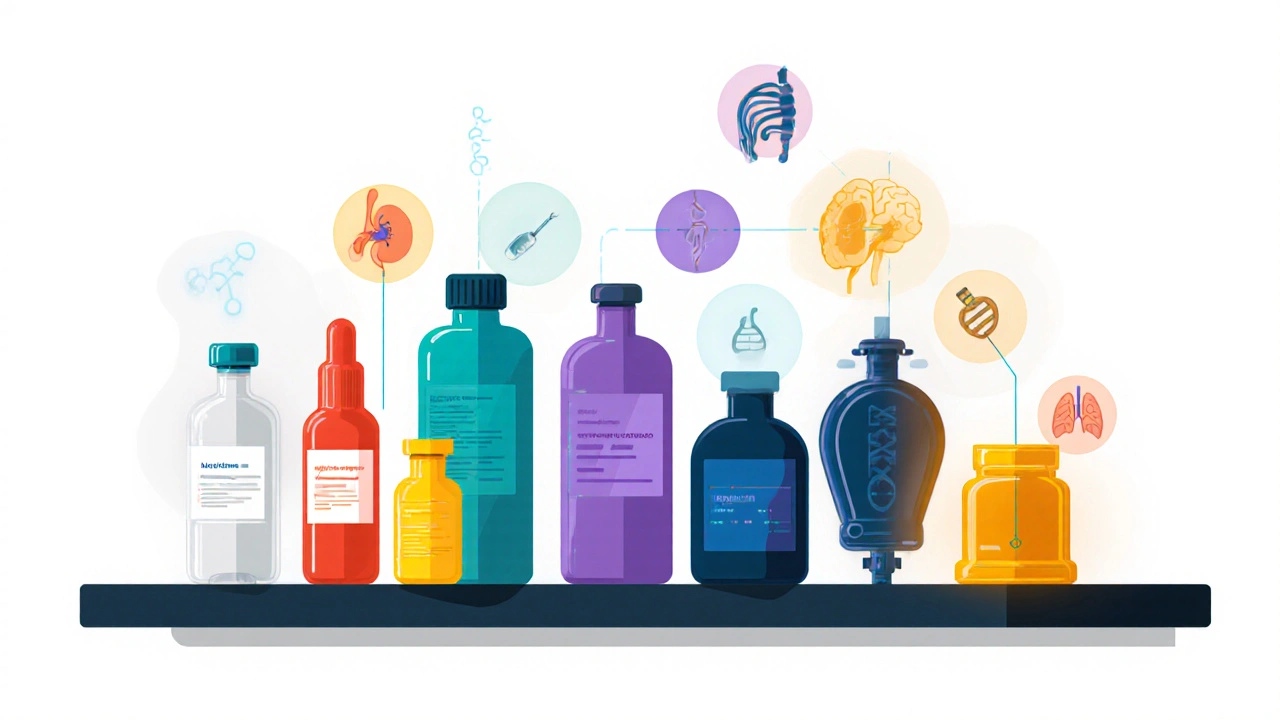
Side Effects and Monitoring
Because the drug attacks DNA, side effects can be significant. The most frequent issues are:
- Bone‑marrow suppression leading to neutropenia, anemia, and thrombocytopenia.
- Hemorrhagic cystitis - irritation of the bladder caused by toxic metabolites.
- Nausea, vomiting, and hair loss.
- Potential long‑term risk of secondary malignancies.
Routine labs (CBC, renal function, urinalysis) are required before each cycle. Hydration and the preventive drug mesna protect the bladder from toxicity.
What Are the Main Alternatives?
If you’re looking for a drug that offers similar disease coverage but a different safety or administration profile, consider these options.
- Ifosfamide - another alkylating agent used for sarcoma and testicular cancer. It shares the DNA‑cross‑linking action but carries a higher risk of neurotoxicity.
- Melphalan - an oral alkylator primarily for multiple myeloma and ovarian cancer. Its side‑effect profile leans more toward mucositis and severe marrow suppression.
- Busulfan - a nitrogen mustard used in chronic myeloid leukemia and as a conditioning agent for bone‑marrow transplant. It can cause pulmonary fibrosis if doses accumulate.
- Methotrexate - an antimetabolite that blocks folate metabolism. It’s widely used for leukemia, breast cancer, and rheumatoid arthritis. Its toxicity centers on liver injury and mucosal ulceration.
- Rituximab - a monoclonal antibody targeting CD20 on B‑cells. Effective for B‑cell lymphomas and some autoimmune diseases, it spares DNA but can cause infusion reactions and infections.
- CAR‑T therapy - a personalized cellular immunotherapy for certain relapsed leukemias and lymphomas. It offers high response rates but requires hospitalization for cytokine‑release‑syndrome monitoring.
Side‑by‑Side Comparison
| Drug | Drug Class | Typical Indications | Administration Route | Major Toxicities | Average Cost (US$) per Cycle |
|---|---|---|---|---|---|
| Cytoxan | Alkylating agent | Lymphoma, breast, ovarian, autoimmune | IV or oral | Myelosuppression, hemorrhagic cystitis | ≈ $1,200 |
| Ifosfamide | Alkylating agent | Sarcoma, testicular, lung | IV | Neurotoxicity, nephrotoxicity | ≈ $1,500 |
| Melphalan | Alkylating agent | Multiple myeloma, ovarian | Oral or IV | Severe marrow suppression | ≈ $900 |
| Busulfan | Alkylating agent | CML, transplant conditioning | Oral or IV | Pulmonary fibrosis, hepatic veno‑occlusive disease | ≈ $800 |
| Methotrexate | Antimetabolite | Leukemia, breast, RA | Oral, IV, intrathecal | Liver toxicity, mucositis | ≈ $400 |
| Rituximab | Monoclonal antibody | B‑cell lymphoma, RA | IV infusion | Infusion reactions, infections | ≈ $4,500 |
| CAR‑T therapy | Cellular immunotherapy | Refractory B‑ALL, DLBCL | IV infusion (post‑manufacturing) | Cytokine‑release syndrome, neurotoxicity | ≈ $375,000 |
Choosing the Right Option: A Practical Decision Guide
Below is a quick roadmap for clinicians and patients. Ask yourself these questions:
- What disease am I treating? Alkylators like Cytoxan excel in lymphoid cancers, while targeted agents (Rituximab) shine in CD20‑positive disease.
- Do I need oral convenience? Melphalan and Busulfan offer oral dosing; Cytoxan can be taken by mouth but often requires IV for higher‑dose regimens.
- How much toxicity can I tolerate? If kidney protection is a priority, avoid Ifosfamide (nephrotoxic) and choose alternatives with milder renal profiles.
- What’s my budget or insurance coverage? High‑cost biologics or CAR‑T may be inaccessible in some health systems; classic alkylators remain cost‑effective.
- Am I planning a stem‑cell transplant? Busulfan and high‑dose Cyclophosphamide are standard conditioning agents; other drugs may interfere with engraftment.
Discuss these points with your oncologist or rheumatologist. The best choice balances disease control, side‑effect burden, and personal circumstances.
Tips for Managing Cytoxan Therapy
Even if you end up staying with Cytoxan, these tricks can make the experience smoother:
- Stay well‑hydrated (at least 2‑3L of water per day) and take mesna as prescribed to protect the bladder.
- Schedule CBC checks before each cycle; consider growth‑factor support if neutropenia recurs.
- Use anti‑emetics (e.g., ondansetron) 30minutes before infusion or oral dose.
- Report any blood in urine immediately-early detection prevents severe cystitis.
- Maintain a medication list; many antibiotics and antivirals interact with cyclophosphamide metabolism.
When you read the guidelines, you’ll often see the word Cytoxan highlighted as a cornerstone drug-that’s because it’s still a go‑to for many clinicians after 70years of use.
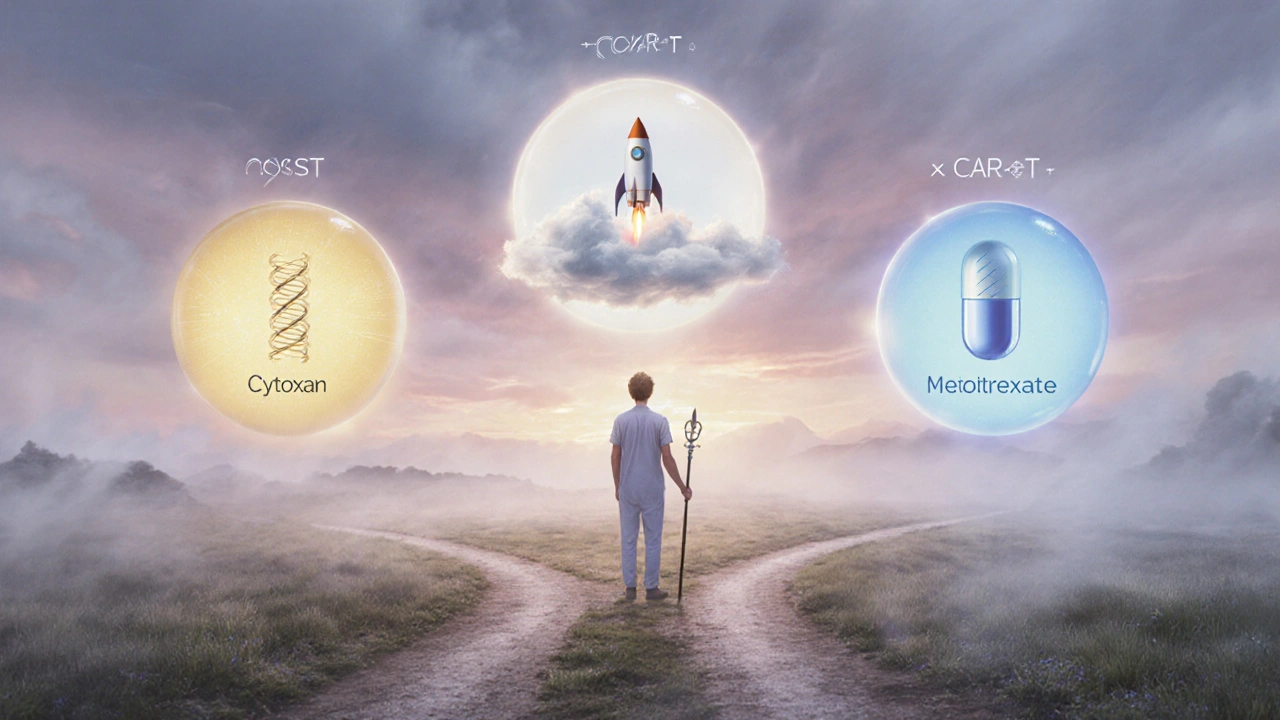
Frequently Asked Questions
Can Cytoxan be used for non‑cancer autoimmune diseases?
Yes. Low‑dose oral cyclophosphamide is a standard option for severe lupus nephritis, vasculitis, and dermatomyositis when steroids alone are insufficient.
How does the efficacy of Ifosfamide compare to Cytoxan for sarcoma?
Clinical trials show Ifosfamide offers modestly higher response rates in high‑grade soft‑tissue sarcoma, but it also carries greater neuro‑ and kidney toxicity. The choice often depends on patient age and renal function.
Is there a generic version of Cytoxan?
Yes. The active ingredient cyclophosphamide is widely available as a generic oral tablet or injectable solution, making it more affordable than brand‑only biologics.
What monitoring is required for CAR‑T therapy?
Patients are observed in an intensive‑care setting for at least 7days after infusion. Labs include cytokine panels, neurologic exams, and daily CBCs to catch cytokine‑release syndrome early.
Why does cyclophosphamide cause bladder irritation?
A metabolite called acrolein accumulates in the urinary tract and irritates the bladder lining. Adequate hydration and the protective agent mesna neutralize acrolein, reducing the risk of hemorrhagic cystitis.



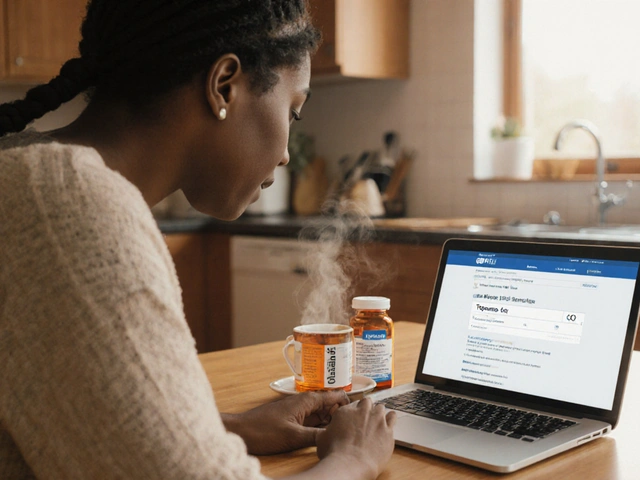


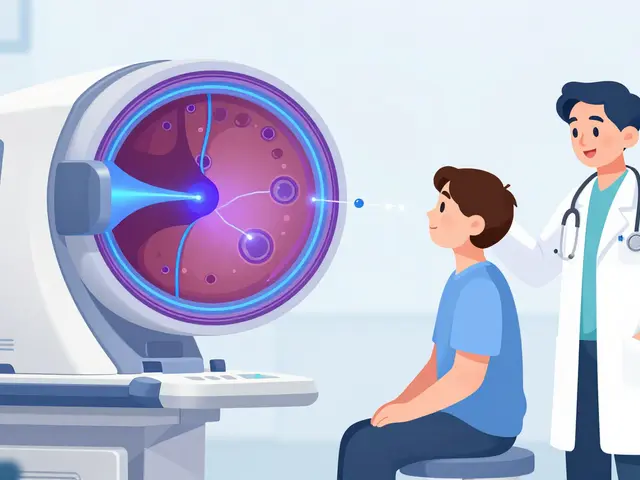

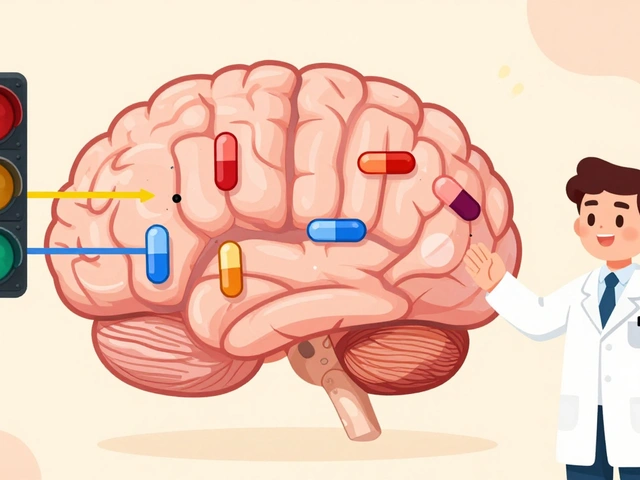
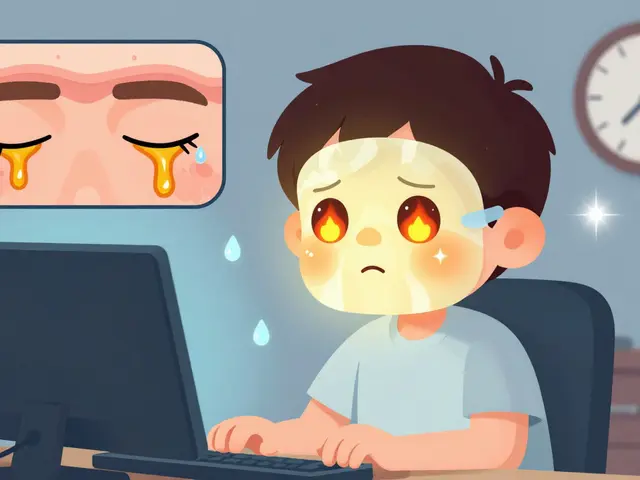
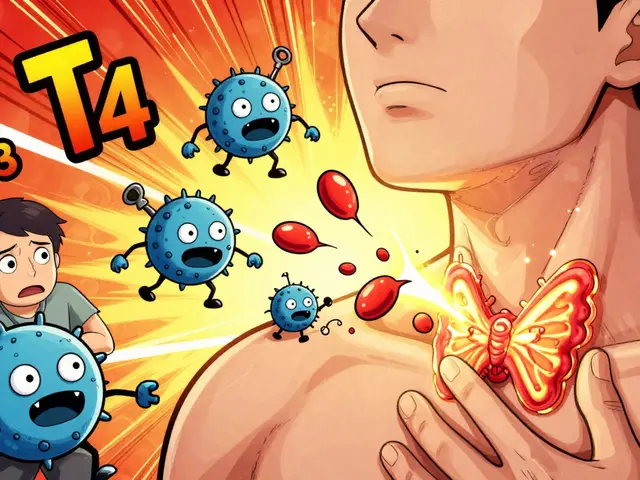
Burl Henderson
Cytoxan’s pharmacokinetic profile is a classic example of a pro‑drug that relies on hepatic activation to 4‑hydroxy‑cyclophosphamide, which then forms phosphoramide mustard cross‑links DNA. This mechanism underpins its broad efficacy across lymphoid malignancies, but also explains the collateral myelosuppression seen in many patients. When you compare it to Ifosfamide, note the latter’s additional need for protective agents like mesna for neuro‑toxic metabolites. Melphalan, on the other hand, offers oral convenience but requires vigilant monitoring for severe marrow suppression. In a cost‑effectiveness analysis, Cytoxan sits comfortably between high‑priced biologics such as Rituximab and ultra‑expensive CAR‑T therapies, making it a viable backbone in many combination regimens.
Leigh Ann Jones
Reading through the table of alternatives, one cannot help but notice how each agent carries its own unique constellation of benefits and drawbacks, which makes the decision‑making process akin to navigating a dense forest of trade‑offs. Cyclophosphamide, the workhorse of alkylating agents, has stood the test of time because its efficacy is well documented across a wide spectrum of both hematologic and solid tumors, and its ability to double as an immunosuppressant in severe autoimmune disease adds a layer of versatility that few other drugs can match. However, the price tag of roughly $1,200 per cycle, while modest compared to monoclonal antibodies, still imposes a noticeable financial burden on patients without robust insurance coverage, especially when multiple cycles are required for curative intent. Ifosfamide, which shares the same alkylating backbone, pushes the envelope a bit further with a higher response rate in certain soft‑tissue sarcomas, yet it brings with it a cocktail of neuro‑toxicity and nephrotoxicity that can be unforgiving for patients with pre‑existing renal impairment. Melphalan, celebrated for its role in high‑dose conditioning regimens prior to stem‑cell transplantation, offers the convenience of oral dosing, but its narrow therapeutic window calls for aggressive growth‑factor support and frequent blood count monitoring. Busulfan, another oral candidate, has carved out a niche in chronic myeloid leukemia and transplant conditioning, but the specter of pulmonary fibrosis looms large, demanding regular pulmonary function testing and dose adjustments. Methotrexate, the antimetabolite darling, provides a low‑cost (<$400) option with proven efficacy in leukemia, breast cancer, and rheumatoid arthritis, yet its hepatotoxic potential mandates baseline liver function tests and periodic surveillance. Rituximab, a monoclonal antibody targeting CD20, revolutionized B‑cell lymphoma therapy, delivering impressive response rates, but the infusion‑related reactions and heightened infection risk require pre‑medication and, in some cases, inpatient monitoring. CAR‑T therapy, the pinnacle of personalized oncology, boasts unparalleled response rates in refractory B‑ALL and DLBCL, but its astronomical cost of over $375,000 per treatment, coupled with the need for intensive care monitoring for cytokine release syndrome, makes it an unrealistic first‑line option for most patients. When evaluating toxicity, the clinician must weigh the myelosuppressive profile of cyclophosphamide against the organ‑specific toxicities of its peers, keeping in mind that supportive measures such as mesna for hemorrhagic cystitis can mitigate some of the adverse effects. Moreover, the route of administration plays a pivotal role; oral agents afford greater convenience and potential adherence benefits, while intravenous regimens allow for more precise dosing and rapid dose adjustments in response to toxicity. Cost considerations extend beyond drug price alone; the ancillary expenses of hospitalization, supportive care, and laboratory monitoring can tip the scales in favor of a less expensive but equally effective oral alkylator. Shared decision‑making with the patient, incorporating personal values, financial constraints, and lifestyle preferences, is essential to tailor the optimal regimen. Ultimately, the choice of therapy does not rest solely on the drug’s efficacy metrics but also on a holistic assessment of the patient’s overall health status, comorbidities, and support system. In this complex landscape, cyclophosphamide remains a cornerstone not because it is the most glamorous option, but because it offers a reliable balance of effectiveness, manageable toxicity, and affordability that is hard to surpass.
Sarah Hoppes
Some people think the pharma giants are hiding the fact that cyclophosphamide is actually a small piece of a larger agenda that controls treatment outcomes by limiting access to cheaper alternatives while pushing newer, pricier drugs onto the market
Robert Brown
Cyclophosphamide is an overpriced junk drug.
Erin Smith
Great rundown! This really helps when choosing a treatment plan.
George Kent
Wow!!! This analysis is absolutely brilliant!!! 🙌🙌🙌 The depth of comparison is exactly what clinicians need!!! The detail on toxicity profiles, cost considerations, and administration routes is spot‑on!!! Keep these thorough breakdowns coming!!! 👍👍👍
Jonathan Martens
Indeed the “hidden agenda” narrative is as pervasive as the off‑label use of cyclophosphamide in refractory cases it’s almost a meme now
Jessica Davies
While some love to spin conspiracy theories it’s more productive to focus on the real data supporting cyclophosphamide’s role instead of chasing shadows
Kyle Rhines
The metabolic activation pathway you described is often under‑scrutinized by regulatory bodies which tend to downplay potential long‑term mutagenic risks associated with alkylating agents
Lin Zhao
Thanks for the comprehensive guide 😊 It really clarifies how each option fits into different treatment scenarios!
Kendra Barnett
Happy to hear it was useful! If you ever need more details on dosing schedules just let me know.
Warren Nelson
I’ve seen patients switch from cyclophosphamide to rituximab when B‑cell markers are high and they tolerate infusions well. The trade‑off is dealing with infusion reactions, but pre‑meds usually keep it manageable. On the flip side, some folks stay on cyclophosphamide for its oral flexibility, especially when they live far from infusion centers. It really comes down to personal preference and how the side‑effects stack up for each individual.
Jennifer Romand
Ah, the eternal battle between convenience and side‑effect tyranny-truly the drama of modern oncology!
Kelly kordeiro
In the annals of oncologic pharmacotherapy, the emergence of cyclophosphamide occupies a singularly venerable niche, emblematic of the era wherein chemotherapeutic innovation was propelled by serendipitous discovery rather than targeted molecular design. Its alkylating modus operandi, predicated upon the formation of interstrand DNA cross‑links, heralded a paradigm shift that conferred cytotoxicity upon rapidly proliferating neoplastic cells whilst inexorably exacting a toll upon the hematopoietic lineage. The subsequent elucidation of its metabolic activation, whereby hepatic cytochrome P450 enzymes convert the parent compound into the bifunctional entity 4‑hydroxy‑cyclophosphamide, was a triumph of pharmacokinetic insight, illuminating the path toward adjunctive prophylaxis with mesna to abrogate hemorrhagic cystitis. Yet, notwithstanding these advances, the drug’s myelosuppressive proclivity remains a formidable adversary, necessitating vigilant hematologic surveillance and, oftentimes, the deployment of granulocyte‑colony stimulating factors to mitigate neutropenic sequelae. Comparatively, agents such as ifosfamide, while sharing a cognate alkylating scaffold, diverge markedly in their toxicity spectrum, imposing neuro‑ and nephrotoxic burdens that render them less universally applicable. The cost considerations, too, warrant meticulous scrutiny; cyclophosphamide, with an average per‑cycle expense approximating $1,200, occupies an intermediary stratum between the modestly priced methotrexate and the exorbitant CAR‑T modalities, thereby furnishing a fiscally prudent option within resource‑constrained health systems. Moreover, the advent of monoclonal antibodies, exemplified by rituximab, introduced a mechanistic departure predicated upon immunologic targeting of CD20, affording clinicians an alternative armamentarium that circumvents the indiscriminate DNA damage inherent to alkylators. Nevertheless, the infusion‑related adverse events, encompassing cytokine release and heightened infection susceptibility, impose their own clinical calculus. In contemporary practice, the selection algorithm for a given malignancy inexorably integrates disease histology, patient comorbidities, financial landscape, and the anticipated toxicity profile, thereby rendering cyclophosphamide a judicious choice in contexts wherein its benefits supersede its detriments. The therapeutic tableau is further enriched by the strategic incorporation of cyclophosphamide within combination regimens, synergizing with agents such as doxorubicin or prednisone to potentiate antineoplastic efficacy. Ultimately, the enduring relevance of cyclophosphamide attests to its robust efficacy, adaptable administration routes, and comparative affordability, qualities that collectively sustain its prominence amidst an evolving pharmacopeia of oncologic interventions.
Chris Fulmer
I appreciate the thorough historical perspective; it’s true that cyclophosphamide’s cost‑effectiveness and versatility keep it relevant, though emerging targeted therapies are gradually reshaping first‑line standards in many cancers.
William Pitt
Exactly-while embracing new options, we shouldn’t discard the tried‑and‑true drugs that still save lives, especially when patients need affordable, accessible treatment.
Jeff Hershberger
The endless parade of “cutting‑edge” therapies often feels like a glossy marketing stunt, while solid, battle‑tested drugs like cyclophosphamide quietly do the heavy lifting behind the scenes.
Jesse Najarro
Well said – every treatment has its place and it’s all about matching the right drug to the right patient